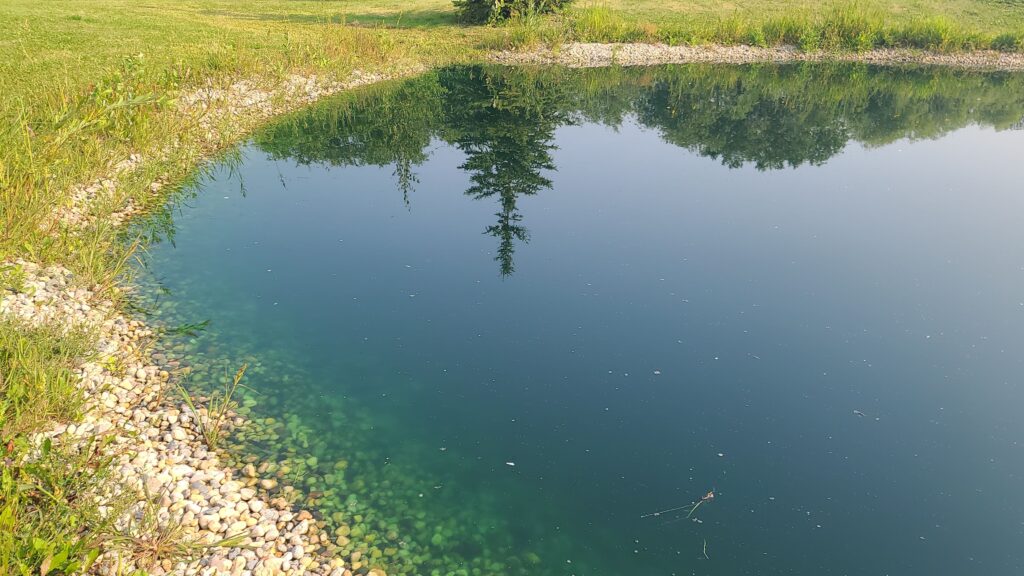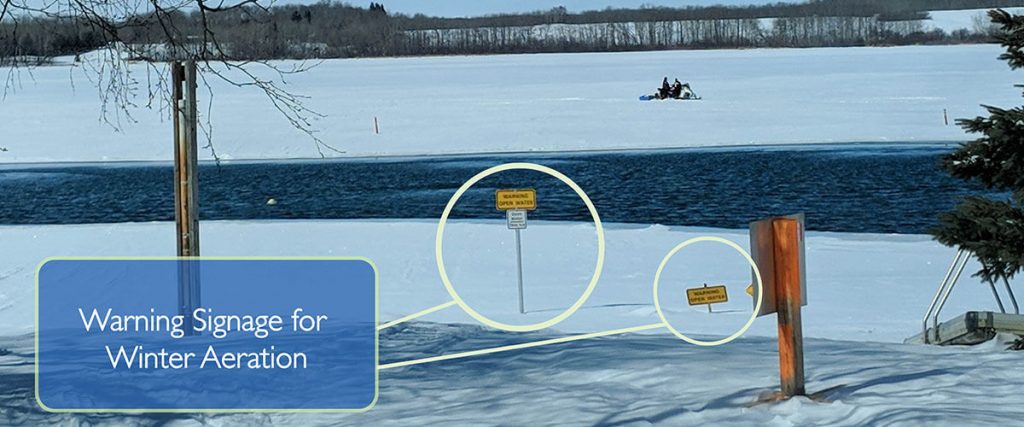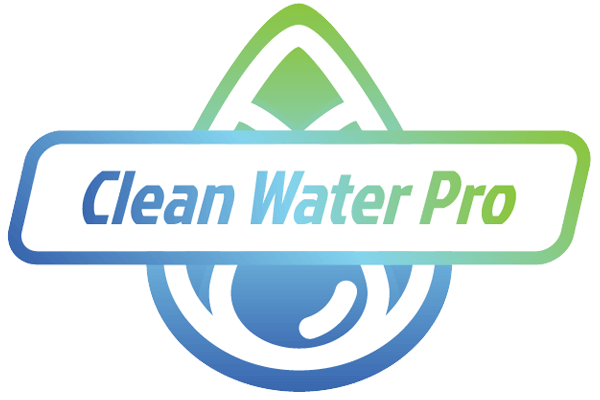Introduction
As fall sweeps in with its golden leaves and crisp air, pond owners need to start thinking about preparing their ponds for the impending winter.
Whether you have a water garden, a Koi pond, or a large dugout, proper winterization is essential to ensure your pond remains healthy and vibrant come spring.
This guide will walk you through the steps to winterize your pond effectively.
Part 1: Preparing To Winterize A Pond
Monitor Water Temperature
Monitor your pond’s water temperature as the temperatures drop.
As the water temperature drops below 10°C (50°F), the metabolic activity of beneficial bacteria begins to slow down significantly. Below this temperature, the bacteria become less efficient at breaking down organic waste.
Once it falls below 10°C (50°F), it’s time to stop using beneficial bacteria, as it becomes less effective in colder water.
Manage Aquatic Weeds & Algae With Pond Dye
If aquatic weeds have been persistent, consider topping up your pond dye before freezing up.
Pond dye is a commonly used tool for managing aquatic weeds, especially for winter preparation.

Here’s how it works and why it’s beneficial:
Pond dye contains pigments that block ultraviolet (UV) light from penetrating the water column. UV light is essential for the photosynthesis of aquatic plants, including algae. By blocking UV rays, pond dye limits the ability of these plants to grow and reproduce.
When you top up your pond with dye before freezing up, you create a darkened environment in the water. The absence of light in this environment hinders the development of aquatic weeds and prevents the early spring growth of algae.
Pond dye can have a lasting effect in early spring. As temperatures rise and the pond thaws, the continued presence of dye can hinder the rapid growth of aquatic weeds, giving you a head start in managing them.
Aeration Considerations
Aeration systems serve as unsung heroes in pond maintenance throughout the year, including the colder months.
While it’s true that you don’t necessarily need to run your aeration system in winter, there are distinct advantages to doing so:
Water aeration ensures a steady oxygen supply reaches the aquatic inhabitants, particularly fish and beneficial microorganisms. This is crucial, especially if you have fish overwintering in the pond. Adequate oxygen levels prevent suffocation and stress, helping fish survive the winter more comfortably.

Aeration is particularly useful during winter if you use the water for households or livestock operations. Aerated water has less odour and is overall healthier.
Water aeration systems create movement on the pond’s surface, which can help prevent complete ice formation. Open patches of water allow for gas exchange, ensuring that harmful gases, such as carbon dioxide, can escape while oxygen enters. This is vital for the fish’s survival and the pond’s overall health. You can read more about winter fish kill prevention here.
Aeration disrupts the stratification of water layers, preventing the buildup of nutrients and deterring the growth of troublesome algae. Algae can still thrive beneath the ice; continued aeration can limit their proliferation. If a pond has a build-up of organics and nutrients, it will utilize the dissolved oxygen in the water and can potentially deplete the oxygen levels in the pond.
There are situations where shutting down the water aeration system makes sense. Check out Part 3: Winterizing Large Ponds, Dugouts, and Swim Ponds for more information.
Part 2: Caring for Water Gardens and Koi Ponds
Managing Leaves
As autumn arrives, nature puts on a breathtaking display of colours, but with it comes a challenge for pond owners – falling leaves.
While they may be picturesque, these leaves can wreak havoc on your pond’s water quality and overall aesthetics when left unattended.
Over time, this leaf litter decomposes, releasing organic matter into the water. This decomposition process consumes oxygen and leads to the buildup of harmful compounds like ammonia and nitrites, jeopardizing the well-being of fish and aquatic plants.
To safeguard your pond from the influx of leaves and maintain its health, consider these two effective strategies:
- Pond Net: One reliable approach is to use pond nets to cover the pond’s entire surface.
- These nets act as a barrier, intercepting leaves before they can submerge and break down in the water. Pond nets are available in various sizes to suit your pond’s dimensions and can be securely fastened to the pond’s perimeter.
- Regularly check and clean the pond nets to ensure they remain effective. Removing collected leaves promptly is essential, as leaving them too long can lead to water quality problems even with the nets in place.
- Waterfall & Skimmer: Many water gardens and Koi ponds feature waterfalls as both an aesthetic and functional element.
- Waterfalls create circulation and aeration, promoting oxygen exchange and helping to deter algae growth. Coupled with a skimmer, which is a device that draws in surface debris, including leaves, the waterfall becomes a natural defence against falling leaves.
- A well-maintained skimmer ensures that leaves and other debris are continuously removed from the pond’s surface before they can sink. The skimmer acts as a guardian, preventing organic matter from entering the water column and causing water quality issues.
- To optimize this strategy, ensure that your waterfall and skimmer are clean and in good working order as fall approaches. Periodically inspect and clean the skimmer’s collection basket to prevent clogs.

Overwintering Koi Fish & Goldfish
Are you tired of the annual ritual of relocating your prized Koi and goldfish indoors for the winter?
Fortunately, with careful planning and the right tools, you can create a hospitable environment in your pond that allows your fish to comfortably weather the colder months.
Winter poses unique challenges for pond fish, especially those in colder regions. As temperatures drop, the water in your pond can become dangerously cold, potentially freezing over completely. This presents two significant issues for fish: oxygen depletion and exposure to freezing temperatures.
Here’s how to successfully winterize a pond with Koi and goldfish:
- A 1500-watt pond de-icer is a valuable tool for overwintering fish. This device, typically a submersible heater, prevents the water from freezing solid in a localized area around it. Maintaining an opening in the ice allows for critical gas exchange, ensuring a continuous oxygen supply to your fish.
- Complementing the deicer, a Koi Air aeration system plays a crucial role in overwintering success. It provides additional oxygenation and circulation in the pond, helping to prevent stagnant water and creating a more hospitable environment for fish. Adequate oxygen levels are essential, especially when fish are less active and demand less oxygen in colder temperatures.
- Proper placement of the deicer and aeration system is vital. Position the deicer near the pond’s surface to maintain an opening in the ice and ensure the aeration system is functioning optimally to distribute oxygen evenly throughout the pond.
Part 3: Winterizing Large Ponds, Dugouts, and Swim Ponds
Water Aeration System Shutdown: How to prepare for the winter
As winter’s chill settles in, it’s essential to consider the status of your aeration system in large ponds, lakes, dugouts, or swim ponds. While aeration offers numerous benefits, including oxygenation and prevention of stratification, there comes a point where it may be prudent to shut it down.
If you have fish that you wish to overwinter in the pond, maintaining an opening in the ice becomes vital. Fish require oxygen even in cold temperatures, and without aeration, the risk of oxygen depletion beneath the ice rises. However, it’s equally important to understand that keeping an area of open water presents safety hazards, especially if the pond is used recreationally. Marking this area with signs or buoys can prevent accidents.
It’s essential to strike a balance by allowing some ice formation while ensuring enough open water maintains oxygen levels.

Aeration System Maintenance: Protecting Your Investment
Deciding whether to leave your Airmax aeration system in place or move it indoors for the winter depends on various factors, including the severity of winter conditions and the system’s design. Leaving it outdoors is feasible, but several precautions are essential:
- If you choose to disconnect the system, it’s crucial to cap the hoses to prevent debris, critters, or insects from entering and potentially clogging the lines.
- Winter is an excellent time to inspect and maintain your aeration system. Check for wear and tear, replace damaged components, and ensure all parts function correctly. Some systems may benefit from a maintenance kit to extend their lifespan.
- If you run the aeration system in winter, ensure it is set up for winter operation. Signs warning that there is thin ice and open water are essential to keep people from falling into the pond.
Conclusion
As fall turns into winter, it’s crucial to take the necessary steps to prepare your pond for the colder months. Whether you have a small water garden or a vast dugout, following these guidelines will help ensure that your pond remains in excellent condition, making for a smoother transition into the vibrant spring days. Remember that properly winterizing a pond provides a healthy and thriving aquatic ecosystem throughout the year.
Here’s a quick review of how you can winterize a pond:
- Temperature Awareness: Keep a close eye on your pond’s water temperature. When it drops below 10°C (50°F), it’s time to halt the use of beneficial bacteria.
- Pond Dye Power: Harness the benefits of pond dye to manage aquatic weeds and algae. Blocking UV rays and inhibiting weed growth sets the stage for easier pond management in the spring.
- Aeration Advantage: Don’t underestimate the role of aeration systems, even in winter. They ensure oxygen supply, prevent ice formation, and keep algae at bay, which is vital for your pond’s health. Maintaining dissolved oxygen levels is important in preventing odour as well.
- Leaf-Proof Strategies: Deal with falling leaves effectively. Whether you opt for pond nets or rely on waterfalls and skimmers, keeping leaves out of your pond is crucial for maintaining water quality.
- Fish-Friendly Winter: Utilize pond de-icers and aeration systems to provide a safe and comfortable environment for your koi pond.
- Large Pond Considerations: Knowing when to shut down your aeration system and maintain the balance between oxygen and ice cover if you have a larger or swim pond. If you decide to run your aeration system throughout winter, ensure it’s ready for cold weather with proper maintenance and inspections, and mark the area to prevent anyone from falling through the ice.
So, as you embrace the beauty of autumn and prepare for the frosty days ahead, rest assured that your pond is in good hands with the knowledge you’ve gained here. Here’s to a successful winterization and the promise of a rejuvenated pond in the spring!
